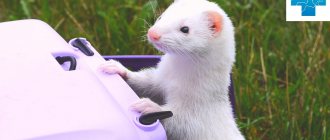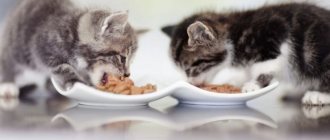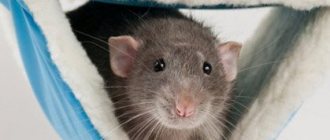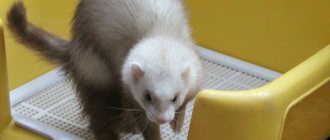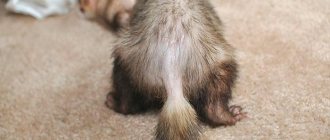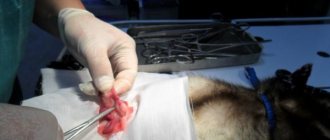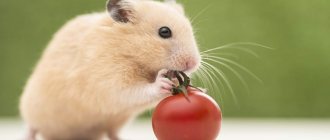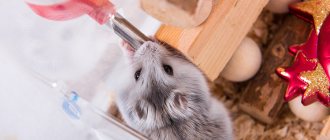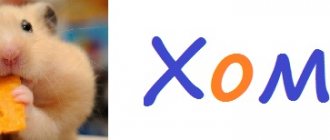The typical representative of the mustelid family is the ferret. They perfectly complement the fauna of the European part of our Motherland, living on forest edges, in the steppes and near large bodies of water. Recently, they are often introduced into homes, because a domestic ferret is a playful and active companion for any family member. However, of no less interest are the wild individuals of the ferret family - predators, aggressive and courageous, who will definitely not allow themselves to be offended.
Feeding ferrets in nature
Ferrets are solitary hunters by nature. In the wild, these animals are predators and feed on rodents. The diet of ferrets consists of hamsters, ground squirrels, rabbits, field mice, rats, and gerbils. Ferrets easily catch lizards, frogs, and hunt poisonous snakes.
These animals have the ability to silently sneak up, ferrets attack hazel grouse, destroy bird nests on the ground in order to eat chicks and eggs. Ferrets' favorite delicacy is hedgehogs; their thorns do not frighten ferrets at all; they eat hedgehogs with great pleasure.
Enemies
In winter, the main dangers for ferrets are wolves and foxes. An encounter with wild cats, birds of prey (eagles, golden eagles or night owls), as well as large snakes can also become unpleasant.
Among the creatures dangerous to ferrets, humans can also be mentioned. Its impact, namely the destruction of nature reserves, the construction of roads and housing in wild areas, can cause the disruption of the ferret ecosystem and the destruction of their habitats.
Ferret diet plan
When keeping ferrets, special attention should be paid to nutrition. After all, an incorrectly selected diet has a negative impact on health. Thanks to the wide variety of options, each breeder can choose the appropriate nutrition plan for himself.
Natural food
From natural products, ferrets are given meat - chicken or turkey, raw, with cartilage and bones, with the exception of tubular ones, and other offal. Breeders add dairy products other than milk to the diet because these animals are lactose intolerant.
Be careful with the fish. Not every type of fish is suitable for ferrets; animals are allowed to be given shrimp, squid, red fish - salmon, trout, but in small quantities.
Natural food should not be boiled; food should be given raw or defrosted.
Dry snacks
Food for ferrets, the ingredients of which include poultry meat containing easily digestible protein of non-vegetable origin - these are snacks. Currently, the market offers dry food, the composition of which was developed by specialists specifically for ferrets. The protein content in dry food is 32-36%, carbohydrates, fats - no more than 20%, up to 5% plant fibers.
In the absence of special food, you can purchase premium food for kittens and pregnant cats. Dog food is absolutely not suitable.
When feeding on dry food, your ferret drinks a lot of liquid, so you need to constantly ensure that the sippy cup is always filled with water.
Live food
Eating live food gives ferrets great pleasure. After all, by choosing such a scheme, breeders get as close as possible to the natural nutrition of these animals in nature.
The following are suitable live food, which is sold in veterinary pharmacies:
- mice;
- chickens;
- mealworms;
- marble cockroaches.
Treats
From time to time the ferrets are given various treats. Ferrets will eagerly eat cheese, cottage cheese, baby kefir and quail eggs, which can be present in the diet once a week. Pieces of fruit are allowed as treats, because ferrets really love apples, bananas, and pears.
Choose your ferrets' treats wisely; don't please them with treats from your table, as this will only cause harm. Indeed, in nature, plant food enters the body of these animals only if it is inside the caught prey.
Vitamins and supplements
For proper development and growth, ferrets need to be given vitamins and minerals. They are part of ready-made additives, which come in two types:
- vitamin pastes;
- vitamin complexes.
Pastes and complexes can be given to ferrets separately or added to food.
Vitamin paste helps animals recover faster, recover and regain strength after undergoing operations. Vitamin complexes are given to ferrets all year round, the dosage varies depending on the season, and the age of the animal is also taken into account.
The vitamins and minerals included in the supplements are important during shedding, lactation and estrus. The additives contain:
- minerals – calcium, phosphorus, magnesium, iron;
- A, E, D and other vitamins;
- Brewer's yeast.
Before choosing a vitamin supplement, be sure to consult a specialist.
Population and species status
- The black-footed ferret is now classified as an endangered species. These animals suffered especially in the last century, when prairie dogs began to be exterminated en masse in order to preserve pastures. Therefore, by 1987, there were only 18 black-footed ferrets. In this regard, it was decided to remove the remaining individuals from the natural environment and place them in zoos in order to breed them artificially. By 2013, the number of this ferret species in nature exceeded 1,200 individuals and the number is constantly increasing even today. Despite this fact, the species has not lost the threat of extinction, and is therefore protected by law.
- Steppe ferret . Populations of this species of animals are practically stable throughout their entire habitat, although there are some fluctuations, which depend on various factors of natural origin. And yet, some subspecies are listed in the Red Book, as they are on the verge of extinction, so scientists are busy artificially breeding them.
- Black ferret . Despite the fact that this animal is found throughout its natural habitat, its numbers are constantly declining. The black ferret belongs to the category of valuable furry animals. More recently, it was hunted en masse, but hunting is currently prohibited.
We can safely say that the number of ferrets around the world is gradually declining, which puts them on the brink of extinction and all thanks to human activity, although he is taking a lot of steps to finally stop this process. Despite such efforts, there are few of them, since not only ferrets, but also many other animals, deprived of natural habitats and food supply, are on the verge of extinction. To stop this negative process, a person will have to invest a lot of money, which today he so thoughtlessly invests in weapons capable of destroying all life on the planet.
In addition to the fact that humans cause irreparable damage to nature, natural disasters are no less dangerous and destructive. Just look at the fires and floods that claim the lives of not only people, but also the lives of a huge number of animals. Of course, if people did not interfere with their natural habitat, the number of animals would be able to recover naturally, although it would take a lot of time.
Ferrets are quite interesting and beautiful creatures that are a real decoration of the wildlife world. Therefore, man’s task should not be to destroy this beauty and uniqueness, but to preserve it, and in our days, to restore it. If this is not done, then our children and our grandchildren will have to live in conditions where such beauty will remain a thing of the past for them. If animals disappear from the face of the earth, then man will also disappear, although he still does not realize it.
Ferret: what kind of animal and what to eat it with
Farshekashi recipes
Farshekasha is a mixture that is often used to feed ferrets. It may contain several ingredients.
Recipe No. 1
Designed for young puppies and growing individuals. The composition of farshekashi includes:
- chicken stomachs – 1 kg;
- chicken necks – 2 kg;
- rice or buckwheat groats – 400 g.
The breeder presented the recipe for farshekashi in his video below:
Preparing farshekash is very simple:
- Grind the cereal into flour, then cook until completely cooked.
- Grind the offal into minced meat, which is mixed with the finished porridge.
- Add vitamins in the required quantities to the minced meat.
Recipe No. 2
This recipe is prepared for adult animals. Farshekasha consists of the following components:
- cottage cheese – 60 g;
- fish – 150 g;
- beef heart – 100 g;
- chicken meat – 0.5 kg;
- rice – 100 g;
- poultry fat – 10 g.
The cooking process is very simple:
- Cook the rice for 2-3 hours, grind the remaining ingredients into minced meat.
- Mix the resulting minced meat with porridge, add the necessary vitamins.
- Divide the finished minced meat into portions and place in the freezer.
Habitats
Animal populations were distributed in the following geographical areas:
- Steppe ferrets in eastern Europe (Hungary, Romania, Czech Republic, Slovakia and Ukraine), Central Asia, Russia (from the Ural Mountains to the Far East) and in the eastern regions of China.
- The forest ferret can be found almost everywhere in Eurasia, especially west of the Ural Mountains.
- The central part of North America, namely east of the Rocky Mountains, is where black-footed ferrets live.
Features of feeding in different periods
The diet of ferrets becomes special at certain periods of life. What remains common is the obligatory presence of minerals and vitamins.
Growth period
During breastfeeding, young ferrets receive the nutrients their bodies need through their mother's milk. Deprived of mother's milk, ferrets' gastrointestinal tract becomes vulnerable to infections, which is why probiotics should be kept in the breeder's medicine cabinet at all times.
Ferrets are transferred to “adult” feeding 3-4 weeks after birth. At this time, their baby teeth begin to erupt. In order for babies to quickly get used to this diet, liquid minced meat is introduced into the diet, and low-fat cream or baby kefir is added to the mother’s menu.
Don’t forget about vitamins - 3-4 drops of fish oil are dripped onto the tongue of ferrets. If more male furos were born in the litter, more calcium and phosphorus are added to the food, since males are more active.
Don't forget to give your pets vitamin pastes and supplements. Lack of nutrients negatively affects the growth and further development of ferrets.
Shedding period
Furo molt in early spring and autumn, with the exception of pregnant females who shed on the 20th day of pregnancy, and animals that have suffered a hormonal imbalance. Shedding lasts 1-2 weeks and is accompanied by severe itching. In some areas of the body there is practically no hair.
Ferrets are very clean, so they carefully lick themselves, as a result of which a lot of hair gets into the gastrointestinal tract and vomiting begins. To prevent this from happening, the animals are given fur-removing pastes. Pets are helped to cope with shedding by combing their fur with a brush or using a furminator.
During molting, ferrets need vitamin complexes containing sulfur, brewer's yeast and B vitamins. Thanks to which the new fur will be thick and shiny.
Pregnancy period
In order for the offspring to be born healthy, a pregnant female is given an individual diet.
The menu of a pregnant female must contain:
- phosphorus, calcium for strong teeth and bones;
- vitamins A, E, D and group B - in increased quantities.
When feeding chorihi with natural food, the menu includes meat and bone meal, calcined cottage cheese, and fish oil. If the female eats dry snacks, she is given special food for pregnant women or a product intended for cats. You can’t overfeed a choriha – this leads to obesity, but limiting the female’s nutrition is also dangerous.
Before childbirth and in the first days after it, the chorikha's appetite worsens. The ferret's menu during lactation is identical to the diet during pregnancy. Nutrient requirements are still high.
A little history
The ancestors of today's ferrets saved many lives in medieval Europe by catching rodents and thereby stopping epidemics. A nimble predator could squeeze in where the cat had no way. At that time they were still semi-wild animals; they were attracted to human habitation by the abundance of easy prey. People tried not to disturb their helpful neighbor, but in gratitude they left a saucer of milk and pieces of fruit for him.
In Russia, the relationship between the choir and the person was far from good neighborly. Our ferrets - forest and steppe - also tend to settle near people. In hungry years, the animals take up residence in sheds on the rural outskirts. The ferret begins to make hunting raids into neighboring buildings until he comes across a poultry house... the clumsy chickens are too tempting prey. The denouement comes quickly: the predator’s path ends in the steel jaws of a trap or in a dog’s mouth.
How to choose dry food?
Before choosing dry food, be sure to read what components are listed in the composition. It is worth paying attention to the following points:
- Poultry meat should be listed first; if it is premium food, then there may be two types of meat.
- The content of plant fibers should be no more than 3-5%, since furo is difficult to digest fiber.
- The percentage of ash should not exceed 7%, otherwise the pet runs the risk of developing urolithiasis.
- The food should contain the amino acid taurine, which is good for the heart and eyes.
- It's best to avoid foods that contain cornmeal, especially if it's listed first.
Location of white spots
One of the criteria for classifying domestic ferrets is the location of the white spots on the body.
There are three options:
- Flash. A flash is a color in which white spots are located on the head. The color of the fur of the eyes and nose does not matter.
- Panda. Pets of this type look luxurious. They have a white head, shoulders and chest. The tips of the paws are also white. The paws themselves are dark, the tail is also dark. There may be dark circles around the eyes. The nose is pink, the eyes are dark brown, rarely ruby. The disadvantage of this type is the frequent occurrence of deafness. Breeders are now working to eradicate this genetic defect.
- Mittens/socks. The mitten/sock type includes ferrets with white spots located on their paws. Any color of fur, eyes and nose.
Ferrets have poor vision, but they compensate for this deficiency with acute hearing and an excellent sense of smell.
What should you not give to ferrets?
There is a whole list of foods that should not be given to ferrets.
| Products | Why not? |
| Pork, lamb | These are fatty meats and are difficult to digest. |
| Pike, bream, pollock, herring, hake | The listed products contain trimethylamine oxide and thiaminase, which interfere with the absorption of vitamin B1. |
| Milk | This product is not digestible and loose stools may occur. |
| Citrus | Allergen, possible itching and rash. |
| Nuts | They are difficult to digest and can cause stomach blockage. |
Lifespan
Living conditions and climate affect the health of the wild ferret. Much depends on the abundance of food and the number of enemies.
Under normal conditions, many forest predators live a long time - about 14 years. For comparison, a rare domestic relative reaches the age of 10–12. The same applies to steppe ferrets. Blackfoot live a maximum of 6–9 years.
Many forest animals die early, becoming prey for hunters, since the animal has a good skin and is dangerous for chickens and rabbits. Some ferrets die under the wheels of cars and are left without their usual shelter and food due to human activity.
The lifespan of these forest predators has decreased significantly. Some researchers are confident that the figure has dropped from 14 to 2–5 years.
Small animals bring a lot of trouble to farmers, which is why some people don't like them. Although the person himself sometimes pushes the ferret “on the high road.” These forest inhabitants are always of interest to scientists, researchers and ordinary people.
Water in the diet
Ferrets often drink liquids, especially if they are fed dry snacks. With this diet, the number of approaches to the drinking bowl reaches 7-12 times. It is important to keep water bowls clean, and the water itself should be fresh, at room temperature. Filtered water is best for drinking and is changed at least 2 times a day.
Ferrets should always have water, because it not only promotes thermoregulation, but also saves the animal from sunstroke in the summer.
Colors
Ferrets with a clear pattern are especially popular among domestic ferrets. All the variety of colors is combined into four main groups:
Standard. The guard hairs and underhairs are pigmented. White color is no more than 10%. Coat color – any. The color can have different saturation - this feature distinguishes standard-colored ferrets from monochromatic ones.
Roan. With this coloring, half of the hair of ferrets is white. The white color of the hairs is evenly distributed along the entire length, or is present only at the base. Along with white hair, gray hair may be present, alternating with pigmented hair. There is a mask on the face.
Siamese. Like Siamese cats, ferrets of the same name have a tail and paws that are darker than the body, and a V-shaped “mask” on the face. The nose is light and may have specks on it. The mask also comes in a T-shape. The color of "Siamese" varies from light brown to dark brown. There are other shades - for example, champagne.
Solid. There is no white fur. The guard hairs and down hairs are colored equally. Any colour. The intensity of the color is the same throughout the body, while all other colors of the paws, abdomen and tail are richer. The animals do not have masks of this color. The eyes match the color of the fur.
Consequences of ferret malnutrition
The choice by breeders of feeds high in fat and carbohydrates, as well as feeding treats in large quantities, leads to the occurrence of various types of diseases, including:
- obesity;
- helminths;
- salmonellosis;
- insulinoma;
- enteritis;
- colitis;
- gastritis;
- pancreatitis;
- hypovitaminosis H, D.
We recommend that you additionally read our article about what diseases ferrets suffer from and how to treat them.
By providing their ferret with proper nutrition, breeders will have a healthy and active pet. Therefore, it is so important to pay special attention to the ferret’s diet and drinking regime, which can change at different periods of life.
0
0
Copy link
The following are NOT KUSTELIDS
- Mongoose, including dwarf mongooses and meerkats. Although they also have anal scent glands and a similar shape, the 34 members of the family Herpestidae are native to Africa, South Asia and Southern Europe.
- Skunks! In recent years they have been officially classified as Mephitidae. Most of the 13 different species are found from Canada to the northern parts of South America. They certainly have the most developed scent glands of all!
- Civets (aka civet cats) and fossa cats (known from the cartoons Madagascar) are viverrids from the viverrid family. They grow in the dense forests of Africa, Asia and some islands.
